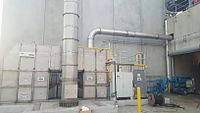
Photo from wikipedia
This paper describes a numerical model that was developed to predict flow and pressure distribution in three multi-branch air duct systems as a function of upstream static gauge pressure. The… Click to show full abstract
This paper describes a numerical model that was developed to predict flow and pressure distribution in three multi-branch air duct systems as a function of upstream static gauge pressure. The duct systems were comprised of a combination of wire-wound flexible ducts and rigid sheet metal ducts. The model used the Darcy equation and the concept of the local loss coefficient, in conjunction with the continuity equation, to perform the calculations. The secant method was utilized to predict the flow rate through the initial upstream branch, and the Newton-Raphson method was employed model the flow through the remaining branches. The model demonstrated that the static gauge pressure rose in the overall flow direction due to the static regain effect, and that flow rate distribution varied in a predictable, characteristic manner in the overall flow direction. The model branch flow predictions were verified experimentally. The model is potentially useful for modeling the performance of variable air volume (VAV) air duct systems that use control strategies that depend on changing the fan speed and/or adjusting damper settings in the branches.
Journal Title: Science and Technology for the Built Environment
Year Published: 2020
Link to full text (if available)
Share on Social Media: Sign Up to like & get
recommendations!